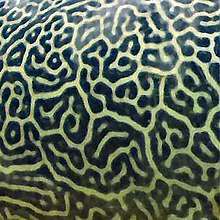The Chemical Basis of Morphogenesis

"The Chemical Basis of Morphogenesis" is an article written by the English mathematician Alan Turing in 1952 describing the way in which natural patterns such as stripes, spots and spirals may arise naturally out of a homogeneous, uniform state.[1] The theory, which can be called a reaction–diffusion theory of morphogenesis, has served as a basic model in theoretical biology.[2]
Reaction–diffusion systems
Reaction–diffusion systems have attracted much interest as a prototype model for pattern formation. Patterns such as fronts, spirals, targets, hexagons, stripes and dissipative solitons are found in various types of reaction-diffusion systems in spite of large discrepancies e.g. in the local reaction terms. Such patterns have been dubbed "Turing patterns".[3]
Reaction-diffusion processes form one class of explanation for the embryonic development of animal coats and skin pigmentation.[4][5] Another reason for the interest in reaction-diffusion systems is that although they represent nonlinear partial differential equations, there are often possibilities for an analytical treatment.[6][7][8]
See also
References
- ↑ Turing, A. M. (1952). "The Chemical Basis of Morphogenesis" (PDF). Philosophical Transactions of the Royal Society of London B. 237 (641): 37–72. Bibcode:1952RSPTB.237...37T. doi:10.1098/rstb.1952.0012. JSTOR 92463.
- ↑ L.G. Harrison, Kinetic Theory of Living Pattern, Cambridge University Press (1993).
- ↑ Wooley, T. E., Baker, R. E. Maini, P. K., Chapter 34, Turing's theory of morphogenesis. In Copeland, B. Jack; Bowen, Jonathan P.; Wilson, Robin; Sprevak, Mark (2017). The Turing Guide. Oxford University Press. ISBN 978-0198747826.
- ↑ Meinhardt, H. (1982). Models of Biological Pattern Formation. Academic Press.
- ↑ Murray, James D. (9 March 2013). Mathematical Biology. Springer Science & Business Media. pp. 436–450. ISBN 978-3-662-08539-4.
- ↑ Grindrod, P. Patterns and Waves: The Theory and Applications of Reaction-Diffusion Equations, Clarendon Press (1991)
- ↑ Smoller, J. Shock Waves and Reaction Diffusion Equations, Springer (1994)
- ↑ Kerner, B. S. and Osipov, V. V. Autosolitons. A New Approach to Problems of Self-Organization and Turbulence, Kluwer Academic Publishers (1994).
External links
- Turing, Alan M. (14 August 1952). "The Chemical Basis of Morphogenesis". Philosophical Transactions of the Royal Society of London B. 237 (641). pp. 37–72. Bibcode:1952RSPTB.237...37T. doi:10.1098/rstb.1952.0012.